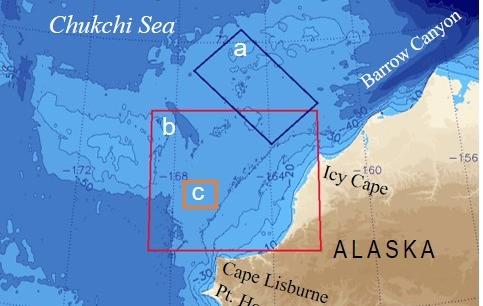
Study area and reference zones for freeze onset (a), Sea Surface Temperature (SST) (b), and ALAMO deployment area (c). AXBT and radiometer SST data were collected over the region between Bering Strait and the northern shelf break. Reference area (a) was selected because of the availability of oceanographic moorings and ship-based CTD data along the PMEL Icy Cape and Distributed Biological Observatory lines that will be available for data validation and other future research.
PMEL is initiating an experimental sea ice fall freeze-up outlook for northern Alaskan waters. The 2017 freeze onset on the Chukchi Sea continental shelf northwest of Icy Cape will begin near the end of November to the first week of December. This is approximately 36 days later than the long-term observed mean (1981-2016).
PMEL researchers with the Arctic Heat Open Science Experiment Based used observations from Air-Launched Autonomous Micro-Observer (ALAMO) floats, deployed in the summers of 2016 and 2017, Airborne EXpendable BathyThermograph (AXBT) arrays deployed in the region that measure ocean temperature as a function of depth from aircraft, and satellite data to project when sea ice freeze up will occur in the Chukchi Sea in 2017.
Float data reveal in real time the presence of ocean heat not detectable by satellite, and provide continuous monitoring of transport, water column stability, and cooling rate. This information is not otherwise available from other observing systems.
Read more about the rationale and data used here. For more information and data, visit the Arctic Heat website: https://www.pmel.noaa.gov/arctic-heat/.


